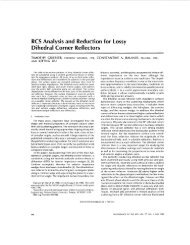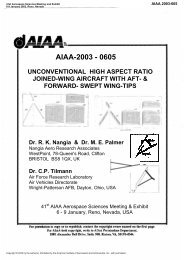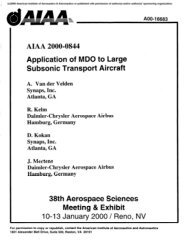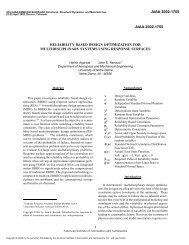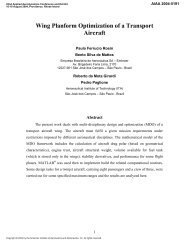The design report
The design report
The design report
Create successful ePaper yourself
Turn your PDF publications into a flip-book with our unique Google optimized e-Paper software.
Note: <strong>The</strong> weights taken after fabrication include wiring and glue for each part. <strong>The</strong>re is<br />
a difference between weights of the 2 fuselages due to different wiring methods. <strong>The</strong><br />
fuselage weight also includes the weight of the vertical tail as it was stuck on.<br />
After the aircraft had been assembled, a correct position of the centre of gravity of the<br />
whole aircraft was to be measured. This is done to calculate the exact positioning of the<br />
battery and other movable weights. It was found that without the payload pod whilst<br />
the batteries were placed at the forward most position in the fuselages, the centre of<br />
gravity was at 32% of wing chord. <strong>The</strong> pod being extremely light did not affect this cg<br />
position. To bring the cg forward, two lead pieces with a total weight of 330 grams were<br />
placed in front of the batteries in both fuselages. This addition moved the cg to 25% of<br />
wing chord with or without the pod. Cg positions of 25% and 32% were marked on the<br />
wing edges for the pilot. If the pilot wanted the cg to be at 25% then payload lead<br />
weights could be placed in front of the fuselages. However, if the pilot wanted the cg to<br />
be at 32% then the lead weights could be placed in the pod underneath the cg. In both<br />
cases, the required payload weight of 500 grams would be achieved at 2 different<br />
change-able cg positions.<br />
Tests 6<br />
<strong>The</strong> final hurdle in any <strong>design</strong> engineers work is the test flight. This is the concluding<br />
phase of <strong>design</strong>ing an aircraft, and occurs after the <strong>design</strong> and fabrication phases of<br />
<strong>design</strong> have been completed. <strong>The</strong> test flight serves as the ultimate test of the success or<br />
failure of the aircraft. In this phase, any flaws from the previous phases will surface, and<br />
areas of weakness and electronic and material malfunctions will be illuminated. This<br />
stage will uncover weakness not only in the manufacturing techniques, but will also<br />
highlight flaws in the basic <strong>design</strong> of the plane.<br />
<strong>The</strong> series of tests which an aircraft is subjected to in this stage is dependent on the<br />
authorities which the aircraft is subservient to. In the case of civilian planes, the Civil<br />
Aviation Safety Authority sets stringent standards and guidelines along which tests<br />
must be conducted. However, whatever level the aircraft is being tested on, the test will<br />
involve analysis of similar sections.<br />
Firstly, the basic structure must be strong enough to withstand the forces acting on it<br />
during maneuvers such as taxi, take off and landing, as well as maneuvers performed<br />
during flight. This structure should ideally prove to be strong enough not just to endure<br />
these forces once, but to be able to endure them repetitively.<br />
Equally importantly, the testing process is <strong>design</strong>ed to check the functionality of the<br />
electronics and wiring of the plane. This must be effective in the control of the plane,<br />
and the powering of the engines, as well as safe enough that it poses little to no risk to<br />
the aircraft or any payload.








![Introduction to RF Stealth [Book Review] - Antennas and ...](https://img.yumpu.com/16857890/1/190x245/introduction-to-rf-stealth-book-review-antennas-and-.jpg?quality=85)

